6.10pm, Wednesday
Stephen Heasley carries out a few final checks at the back of the lorry to make sure the load is secure.
As a cold mist drifts down over him from the minus-22-degree air inside, he pulls at a metal bar that will keep the 20-plus tonnes of frozen chicken in his refrigerated lorry in place for the 620km journey – lasting 12 bumpy hours – to the east midlands of England.
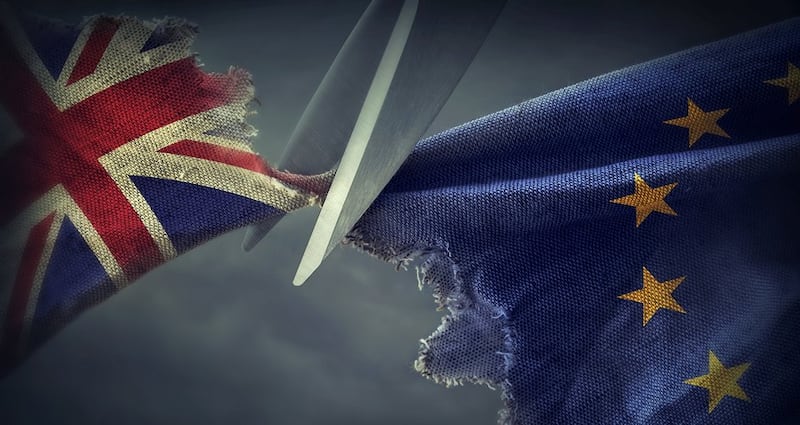
The chicken has come from a processing plant in Dungannon, Co Tyrone and before that from Northern Irish farms. Our destination is a cold-storage facility outside Grantham in Lincolnshire. Grantham is probably best known as the birthplace of Margaret Thatcher, but it's also one of the locations where Northern Irish chickens are dismembered, sent for repackaging and distributed to supermarket chains such as Tesco, Sainsburys and Aldi across the United Kingdom and Ireland.
Transport companies run on delicate profit margins and strictly regulated driver hours. For businesses that, like them, rely on certainty, Brexit is chaos
It is another type of dismembering that Heasley and other hauliers fear most: the chopping-up of delicately balanced supply chains. These ensure that animals reared in one island and processed in another can be prepared for customers across both jurisdictions, guaranteeing that products maintain the commercially viable shelf life of five to six days that keeps supplies flowing and money changing hands.
The UK voted to leave the European Union 28 months ago and yet, with less than six months to go to "Brexit Day" (the UK is scheduled to leave at 11pm British time on Friday, March 29th, 2019), British and European politicians have not agreed an exit deal. Such a deal would protect those supply chains while both sides hammer out a longer-term agreement governing future trading between the world's second-largest economic bloc and its fifth-largest economy.
Heasley – a 43-year-old from Lisburn, Co Antrim – knows the road ahead better than most. He has made the journey from Portadown, Co Armagh, across the Northern Ireland-Republic of Ireland Border and on to Dublin Port, Holyhead and then England many, many times in his two-decade career driving lorries.
“Watch yourself, there’s a bump coming up,” he says, pointing into the distance to a ridge you still can’t see, minutes after we have pulled out of the haulage yard of Manfreight, the Portadown company he works for.
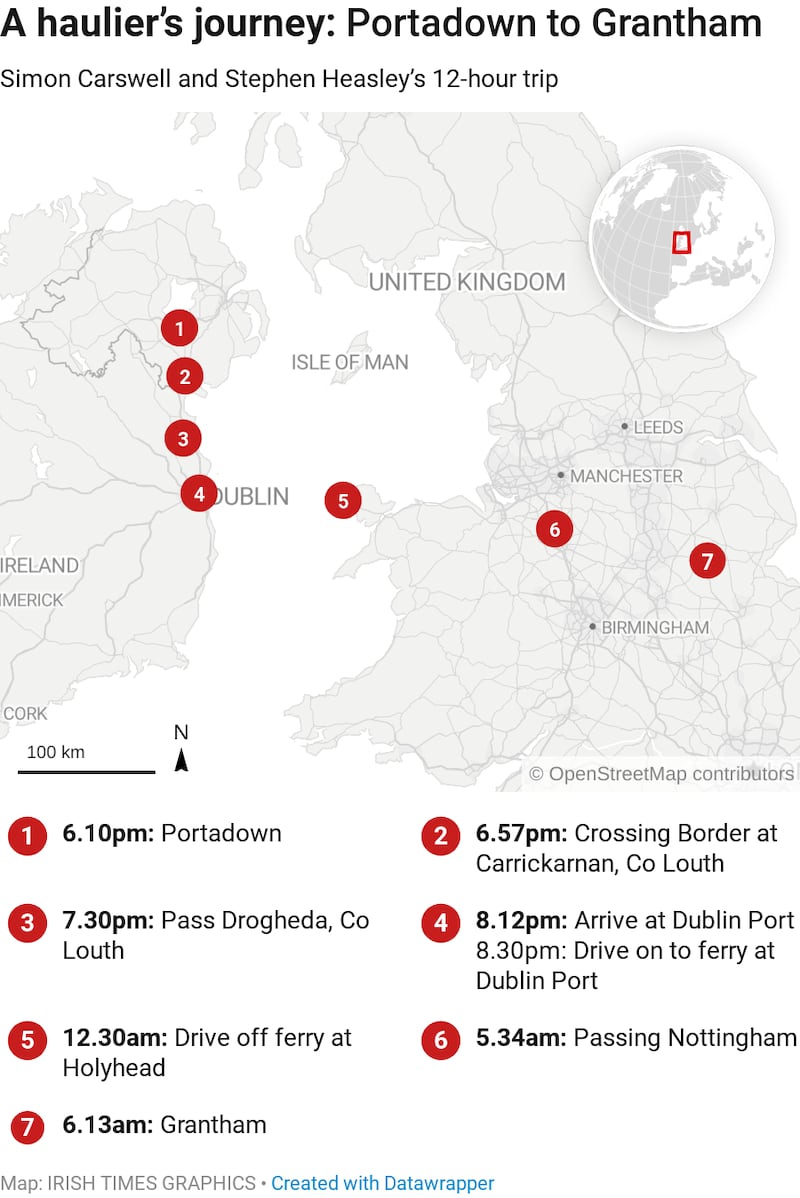
You tend to feel most things on the road in a 44-tonne, 500-horsepower Volvo FH4 lorry, particularly with a load of between £40,000 (€46,000) and £60,000 (€68,000) worth of frozen chickens in the back.
Heasley and hauliers like him feel Brexit more keenly than most of us, but they know too that the political road ahead is difficult to navigate.
Transport companies such as Manfreight have developed decades-long supply routes, carefully managed on delicate profit margins and strictly regulated man-hours for the company’s 180 drivers. For these businesses, which rely on certainty, Brexit is chaos. Nobody knows what will happen, and planning ahead is complex.
“There is nothing an average man or company can do because they don’t know what is going to happen,” says Heasley, 11 kilometres from what is right now an invisible border.
“They don’t know what they can do. They just don’t want delays.”
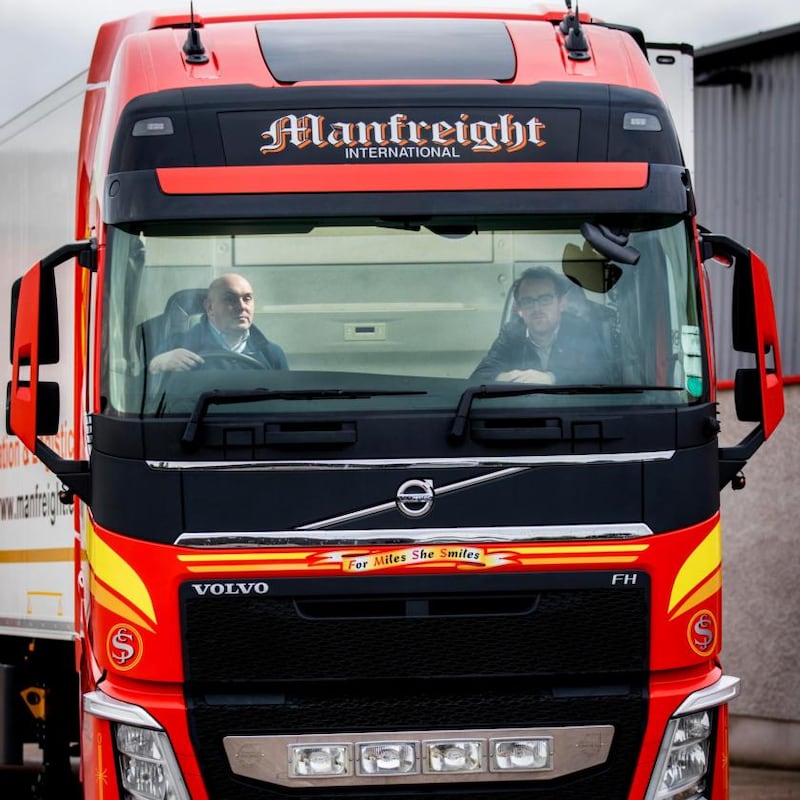
6.57pm, Wednesday
From Portadown, it is about 140km to Dublin Port. Heasley knows he can make the 8.40pm Stena Line to Holyhead in plenty of time. There is little traffic on the road this Wednesday evening.
Less than an hour into our journey, as we approach the Border, the Volvo truck is powering ahead steadily at 56mph, or 90km/h. Suddenly, the continuous white line on the side of the road becomes a broken yellow one, and roadside signs turn bilingual, in Irish and English. Speeds and distances now appear in kilometres rather than miles. These are the only indicators that we have crossed the Border at Carrickcarnan, Co Louth.
“Other than that, you wouldn’t know the difference,” says Heasley.
Brexit has left a dark cloud of uncertainty over this border road and the rest of the 499km frontier from Carlingford Lough to Lough Foyle.
While the EU and UK have said they want to avoid a hard border post-Brexit, they still have not agreed a plan to achieve this. Both have agreed that within the treaty covering the UK’s exit from the EU there must be a “backstop” – a guarantee to have no hard border unless and until a future trade deal offers a better solution to avoid one – but no backstop has been agreed.
It has become the most intractable part of the Brexit negotiations, threatening to scupper an overall exit deal and heightening the pressure on EU and UK negotiators to agree some compromise for this week’s crunch EU summit in Brussels.
“Nobody is actually sure what’s going to happen with the Border,” says Heasley, eyes fixed on the road ahead. “We’re hoping for transport companies’ sake and the customers’ sake that there are no border crossing checks and no security, because it will have an impact on us as drivers and the loads we are carrying.”
He explains that under EU rules heavy goods vehicle (HGV) drivers must have a 11-hour rest every day, though it can be reduced to nine hours, three times a week. That means from the moment a driver starts driving, they have a 15-hour period – a “spread-over,” Heasley calls it – to get their goods to a destination.
And there are plenty of goods heading to destinations on these roads. The Revenue Commissioners estimates that 13,000 commercial vehicles cross the Border every day. The UK’s Freight Transport Association has warned that a bad or no-deal Brexit could lead to “near-paralysis of freight” at the Border.
Some Northern Irish hauliers have tried to Brexit-proof their businesses. Manfreight has opened an office in Clonshaugh, north of Dublin. Others are unwilling to invest without knowing what Brexit will likely bring.
"It is that lack of clarity, people are unwilling to take a gamble," says Seamus Leheny, policy manager at the Freight Transport Association in Northern Ireland.
The boat waits for no man. It is not interested because some customs man kept me for an hour or two up the road
Driving across the Border, we have about an hour and a half to make the 8.40pm ferry. If we miss that boat, the next one from Dublin Port to Holyhead is at 2.15am. This would mean pulling out of the port at Holyhead on the other side of the Irish Sea at around 6.15am. With more than four hours driving still to go to reach Grantham – and with Heasley’s 15-hour spread-over expiring at 9am – he would not get there in time.
“That is what a driver is up against,” he says. “If I was out of time, they would have to find another driver to lift that food. It might not be our man; it might be a subbie. You have all that additional cost either way.”
The margin of error is extremely narrow. Any kind of delay on the Irish Border after Brexit could knock a tight schedule for a haulier like Heasley out.
“The boat waits for no man. It is not interested because some customs man kept me for an hour or two up the road,” he says.
Heasley’s colleague Henry Totten, a 75-year-old who has been driving since he was 21, knows about delays at the Border better than most from his days transporting goods north and south at the height of the Troubles. Checks on the goods he was hauling had to be carried out by customs agents on either side of the Border, in both Newry and Dundalk, and then at the Border itself, adding up to five hours to a journey time.
“You were wasting half a day no matter what way you looked at it,” he says.
Carrying “groupage” – a mix of goods collected from different customers to create an economic full-load – made customs checks even more complicated, he recalls.
“You could have sat there all day. The customs official could have said, ‘I want to see such and such an article,’ and you would have to take half the load off to get to it,” says Totten.
Now he can complete a run from Northern Ireland to Cork and back in a single day.
“It is the best thing since penicillin,” says Totten of the invisible border that has been in place for more than 20 years. “You have no stops to do.”
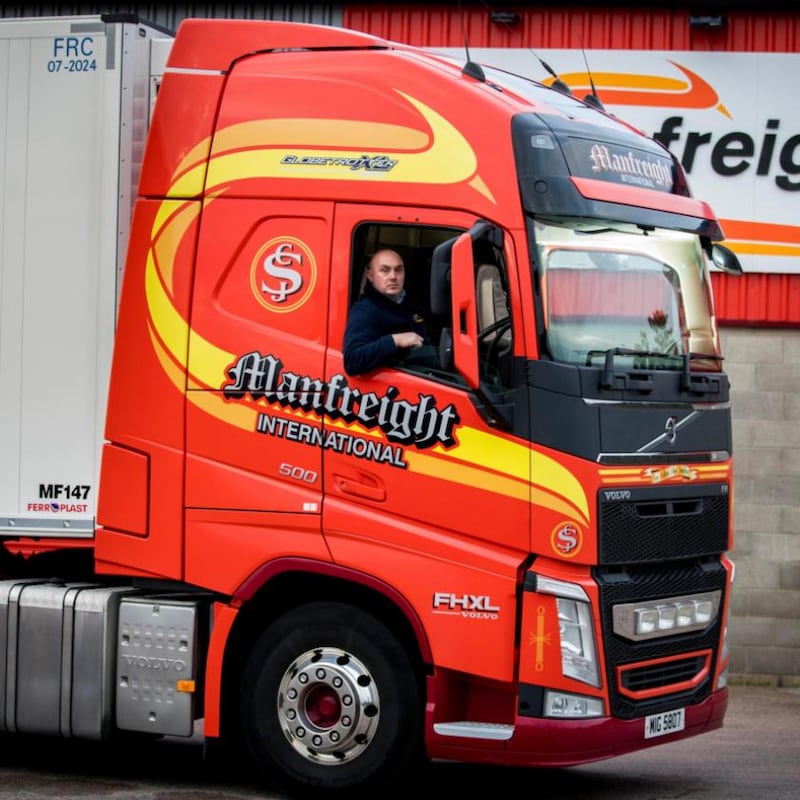
8.12pm, Wednesday
We make good time to Dublin. There was just a two-minute slow-down at an M1 toll booth north of Dublin city and some light traffic heading into Dublin Port.
Heasley drives into the holding lorry park at the port with 28 minutes to spare before the ferry leaves.
The port is Ireland’s busiest for freight by some distance. Central Statistics Office figures show that 992,295 loaded freight vehicles and trailers passed through the port in 2017. It is a key transit point to access the UK from Ireland and over the so-called UK “land-bridge” to continental Europe.
The Freight Transport Association estimates that 60 per cent of the 475,000 freight containers shipped to Britain have their final destination in Britain and that most of the remainder ends up being transported on to other parts of the EU.
Welsh first minister Carwyn Jones said on a visit to Dublin this week that some 70 per cent of goods moving between Ireland and Britain pass through Holyhead and Pembroke Dock, the other Welsh port for freight transportation. “Any kind of delay is bad. It is not just bad in terms of being able to export from Ireland into Great Britain, but onward traffic going through Dover into the continent. This point has been made to me by Irish haulage companies,” Jones says.
Any collapse in Brexit talks could hurt Ireland’s trade with the UK and the rest of the EU. There is lots at stake: Ireland exported €14.8 billion of goods to the UK in 2016 – 12.5 per cent of all the country’s exports, while it imported €20.5 billion – 28 per cent of all imports coming into the country, according to the Central Statistics Office.
As Heasley drives his lorry into the port, an official tells him that all the “plug-ins” on the boat have been taken. This means he cannot plug into an electricity mains to keep his refrigerator running. Trucks are prohibited from running their own engines for the duration of the roughly 3½-hour sailing to Wales.
Heasley’s chickens are frozen so it is not a problem on this trip, but if he was carrying fresh “just-in-time” products such as dairy items – yoghurts, ice cream and the like – or “something that is a bit vulnerable”, he would need a plug-in. Otherwise, “a lollipop would run off a stick,” he says.
At the check-in hut at the port, Heasley discovers he is not booked onto the ferry. There has been a mix-up. He makes a phone call back to Manfreight and, a few minutes later, Heasley has our tickets in his hand.
Eighteen minutes after arriving at the port – and with no checks of his goods on board – he drives onto the ferry at 8.30pm, the third-last lorry onto the boat with 10 minutes to spare before departure.
Brexit and border hold-ups could mean missing a crucial delivery window, landing additional costs on the haulier
Upstairs, we tuck into a meal of meatballs and chips in the Truckers’ Restaurant, surrounded by grey-looking drivers dressed in checked shirts, combat T-shirts and baseball caps.
Heasley says that some of the chicken we are transporting will end up being served in fast-food restaurants back in Ireland after being processed and breaded in another factory before being distributed to customers. This is how circular supply chains work in Britain and Ireland. The economies are more closely intertwined than many consumers realise.
He explains the meticulous choreography of supply chains: hauliers often have a set time to deliver food produce to a distribution centre in time for other lorries to transport it on to other processing centres.
Brexit and border hold-ups could mean missing a crucial delivery window, landing additional costs on the haulier. Regular delays might even lead to the loss of contracts to suppliers operating closer to the distribution centre. It is all about maintaining the critical shelf life of products. Fail to do so, and costs could increase and availability of products could fall.
“Down the line, everybody will pay for it,” says Heasley. “It is going to have an impact across the board.”
A day before our journey, Heasley’s boss, Chris Slowey, Manfreight’s owner, explains that drivers are the biggest commodity in the haulage business, and a driver being delayed for one 24-hour cycle a week because of Brexit would mean a requirement for 20 per cent more drivers when there are shortages of drivers generally.
“If each driver of ours loses a day, it would effectively mean we would have to renegotiate all our rates with our customers,” he says, explaining the havoc Brexit could cause freight operators.
“From an exam to a marriage, you have a period of preparation because you know what is coming. With Brexit there are so many unknowns,” he says.
On the ferry over dinner, Heasley explains other challenges lorry drivers face on the road: diesel stolen from tanks while drivers sleep in their cabs; “curtain sider” lorries being knifed open and goods stolen; toilet emergencies.
An unintended consequence of Brexit-related delays at borders could lead to a boom in sales of Lucozade and Oasis drinks bottles, both popular with lorry drivers who have to answer the call of nature on the road. “They have a wider neck,” Heasley explains. He makes clear this is not something he resorts to himself.
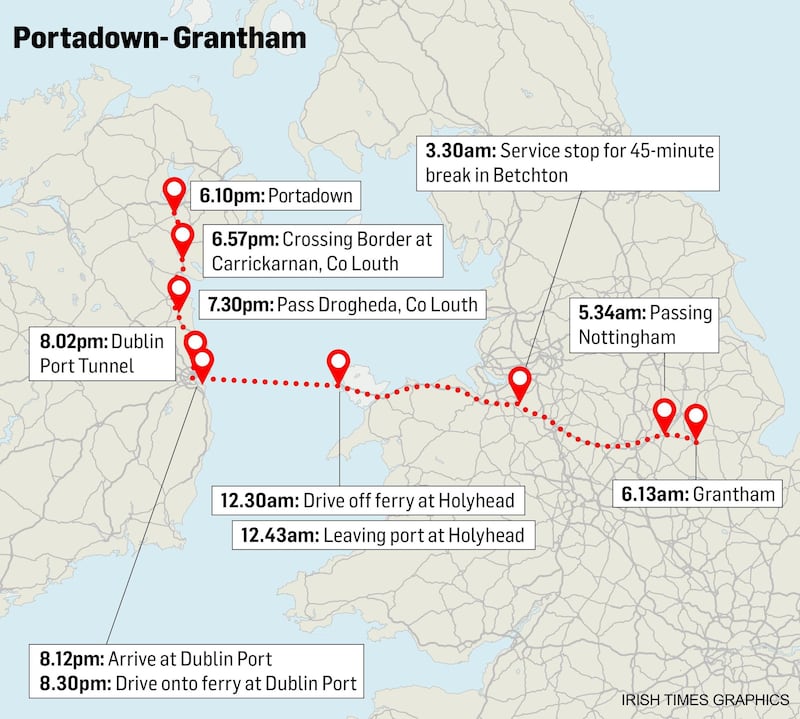
12.30am, Thursday
Four hours after driving onto the ferry in Dublin, Heasley drives down the ramp at Holyhead. Apart from a short delay as a result of congestion from hundreds of trucks disembarking from two ferries arriving at the same time in Wales, we are out of the port within 13 minutes. Only one piece of paperwork is handed in to a port official.
“Everything’s smooth. Everything’s all right,” says Heasley as he heads for the dual-carriageway and the M56 to take us to the M6, the motorway spine running down the west of England from the Scottish border.
Heasley explains that the majority of Manfreight’s traffic goes “over the top” via ports at Larne and Cairnryan, through Scotland and down into England. This route makes sense for deliveries in the north of England because there is less driving time required, but a lower speed limit in Scotland is a big downside.
The strict limits on driving times determines everything, however.
“Going through Dublin tends to be easier,” says Heasley. “If a man’s going to the south of England, it just means it brings you out in the middle of England so you have less driving time.”
Barrelling down near-empty roads as we cross into England, Heasley says he was not among the 56 per cent of Northern Irish voters who elected to remain in the EU in the June 2016 referendum. He voted Leave along with other “lorry men” because of strict EU rules on drivers and their hours, and the heavy fixed penalties that enforce them.
The damage he saw to lorries at Calais port in France during the migrant crisis also encouraged him to vote Leave. Information shared on lorry driver groups on Facebook about what was happening to the lorries and drivers helped to sway his vote, he says.
People never knew when they voted what the impact of Brexit was going to be. It is going to be more expensive to run a haulage company. I never understood that at the time
“People never knew when they voted what the impact of Brexit was going to be,” he says.
He points to the British morning TV interview with Brexiteer Nigel Farage the day after the referendum, when Farage admitted that the Leave campaign misled the public about EU money going to the health service post-Brexit.
Does he regret voting to leave now?
“Aye,” says Heasley. “I believe Brexit is going to impact on our cost of living, so I do. It is going to be more expensive for a man to run a haulage company now than it was previously. People don’t understand that. I never understood that at the time.”
And if he had the opportunity to vote again? “I wouldn’t have voted Leave,” he says.
As Heasley explains the challenges around the EU regulations, he grimaces – and it has nothing to do with the regulations. “That’s a rabbit I just killed there,” he says.
Our early-morning discussion turns to roadkill, the perils of speeding, his advice for trainee drivers and his favourite route (dawn on the West Pennines, he says).
“I killed a deer one time on the A75 in Scotland . . . bigger than a dog,” he says.
3.30am, Thursday
Heasley pulls into a services stop near Crewe in England, still almost two hours from our destination in Grantham. He has hit his four-hour driving limit so, under EU regulations, he has to take a 45-minute break.
Inside, we grab a tea and coffee and some chocolate. Heasley explains the dietary toll and the poor physical shape this gruelling work life leaves some lorry men in. Heasley sometimes likes to walk up and down factory yards for exercise after “tipping” his loads.
After Heasley’s compulsory 45-minute rest-up and a quick check that the temperature around the chickens is still well below freezing, we are back on the road.
6.13am, Thursday
Still in darkness, Heasley navigates a final dangerous junction, waiting a few minutes for a safe gap to cross two lanes of fast-moving oncoming traffic. The morning commuters are on the road. A little after 6am, we pull in to our destination: the cold store in Grantham.
Heasley exchanges paperwork at a check-in hut and pulls around the back. He opens the back door for the first time since Portadown and reverses the six-axle lorry slowly up to a hatch for the chickens to be unloaded.
It is completed in 19 minutes, leaving him with more than two hours still to go within his driving limit. That is enough time to head north and make his next collection point for his return back to Portadown “over the top” via Scotland.
“Smooth and no delays,” he says of the 12-hour, 22-minute door-to-door trip.
Brexit will likely make this journey rougher, he acknowledges, given the potential for delays at the Irish Border or at Holyhead once the UK is no longer in the the EU.
“Come March it is a different story, all uncertain,” he says, before starting the next leg of his journey.
EXPLAINER: BORDER PROPOSALS
- EU and UK officials have been locked away in negotiating rooms in Brussels trying to devise a plan that would prevent Irish Border stops for hauliers like Stephen Heasley.
- Talks have been deadlocked for months on the backstop – the "safety net" to maintain an invisible border post-Brexit should no other option be found.
- Among the solutions being considered are dual registration for VAT, in Northern Ireland/UK and the Republic of Ireland, and dual certification of Northern Irish products in both the UK and EU.
- This would mean that any goods made in Northern Ireland would be registered for VAT and certified both in the UK and EU. This would remove the need for any checks on the Irish Border or elsewhere in Ireland to monitor that goods are meeting EU standards. They could then move freely in lorries through Ireland, the UK and continental Europe.
- The DUP, which is keeping Theresa May's Conservative government in power in Westminster, and May's government itself rejected the EU's proposed backstop, produced in February, that would keep Northern Ireland under EU economic rules post-Brexit. It would, they said, put a border in the Irish Sea and split Northern Ireland economically and constitutionally from the rest of the UK.
- EU negotiator Michel Barnier and his Brexit "task force" team have tried to "de-dramatise" their backstop in an effort to make the proposals politically acceptable.
- Ireland has been treated as an all-island unit for animal health for many years; livestock coming into Northern Ireland from Britain through Larne Port are already checked by veterinary inspectors. Barnier and his negotiators have been stressing that any further backstop checks would not be new but just increasing these checks to 100 per cent, as opposed to the 10 per cent that take place currently.
- Another way to cool the political heat around checks between Northern Ireland and Britain, suggested by EU negotiators, would be to move customs and regulatory checks to Dublin Port (the Irish Government estimates that more than 60 per cent of goods moving between Ireland and Britain already pass through here). This would avoid any checks within the island of Ireland.
- These suggestions are all subject to difficult negotiations between the EU and UK in the run-up to next week's Brexit summit of EU leaders in Brussels.











